Jun
22
Women’s Issues Make Zaid Shakir Look Away
June 22, 2007 | 1 Comment
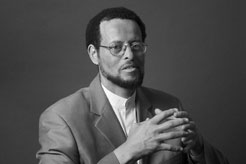 When interviewed tonight on Bill Moyers’ Journal, Imam Zaid Shakir appeared relaxed, looking straight at Mr. Moyers with his light brown eyes. But when the subject turned to the question of the divine mandate for wife-beating, Imam Shakir appeared flustered.
When interviewed tonight on Bill Moyers’ Journal, Imam Zaid Shakir appeared relaxed, looking straight at Mr. Moyers with his light brown eyes. But when the subject turned to the question of the divine mandate for wife-beating, Imam Shakir appeared flustered.
Moyers read to Shakir a translation of the Koranic verse 4:34, which, in the Yusuf Ali translation, reads in part:
As to those women on whose party ye fear disloyalty and ill-conduct, admonish them (first), (next) refuse to share their beds, (and last) beat them (lightly); but if they return to obedience, seek not against them means (of annoyance): for Allah is Most High, Great (above you all.)
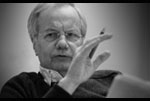 Moyers described this verse as written by men, for men, and asked Shakir: Couldn’t some men interpret this as divine sanction to beat their wives? (As of 10:40 PM June 22, the show’s transcript was not online.)
Moyers described this verse as written by men, for men, and asked Shakir: Couldn’t some men interpret this as divine sanction to beat their wives? (As of 10:40 PM June 22, the show’s transcript was not online.)
ReligionWriter was curious to see if Shakir would mention a recent translation of that verse by an American Muslim woman, which rendered the word formerly translated as to “beat them” to read “go away from them.” Shakir did not reference that translation, indicating that the new translation has not yet been embraced by mainstream Muslims like Shakir.
Instead, he made the point that the verse must be read within the context of the entire Koran (i.e. where justice and mercy are commanded,) and that men who beat their wives would do so with or without divine sanction.
Moyers then pressed Shakir on the issue of woman-led prayer — a concept Shakir rejects. Moyer asked him if, in fact, American Muslims would have to adapt to “American” standards and accept female religious leadership. Moyers repeated use of the word “American” — along with his somewhat impassioned tone — seemed a bit odd, given that many American religious groups do not accept female clerical leadership. For example, GOP presidential hopeful Fred Thompson’s church, the Churches of Christ, do not allow women to preach or lead a mixed congregation. In the Mormon church, only men can access the priesthood; in the Catholic Church women’s ordination is not allowed.
Perhaps the most interesting aspect of the interview with Shakir was his description of his mother, as a thoughtful and well-read single mother of seven. Next month, Shakir’s sister is publishing her mother’s diary, Dear Self: A Year in the Life of a Welfare Mother. In the Moyers segment, Shakir speaks of how his mother’s intellectualism shaped his life and made him who he is today. Entirely aside from viewpoints on Islam, Shakir seems to have a fascinating personal story — rising from poverty to study at some of the best universities in the U.S. and Muslim world, and now becoming a major Muslim American leader.
(UPDATE: transcript now available)
Apr
23
Book: Why Horror Attracts, and How We Memorialize It
April 23, 2007 | Leave a Comment
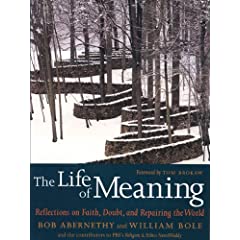 Bob Abernethy, founder and host of PBS’s Religion and Ethics Newsweekly, and co-editor William Bole have compiled 66 of the show’s most interesting interviews in “The Life of Meaning: Faith, Doubt, and Repairing the World,†published this month by Seven Stories Press. Compressed from lengthy Q+As into “spoken essay†form, the brief chapters offer short bursts of insight. Read today, a week after the Virginia Tech shootings, two of these chapters in particular pose provocative questions about how we relate to public tragedy.
Bob Abernethy, founder and host of PBS’s Religion and Ethics Newsweekly, and co-editor William Bole have compiled 66 of the show’s most interesting interviews in “The Life of Meaning: Faith, Doubt, and Repairing the World,†published this month by Seven Stories Press. Compressed from lengthy Q+As into “spoken essay†form, the brief chapters offer short bursts of insight. Read today, a week after the Virginia Tech shootings, two of these chapters in particular pose provocative questions about how we relate to public tragedy.
In the chapter titled “Staring Down the Gods of War,†Chris Hedges, a former foreign correspondent for The New York Times, tells Religion and Ethics Newsweekly that the intensity of combat can “very swiftly become an addiction….You are thrust into the present in a way that is like a drug. I mean, even the colors are brighter.†The Virginia Tech violence was, in a sense, a three-hour war, Seung-Hui Cho versus the world. And just as war movies, war reenactments and other war mythologizing are perennially popular, so the public has returned again and again to dip into the seemingly endless stream of media content, which now includes portraits of the individual victims, narratives of Cho’s troubling past, and even interactive graphics that retrace the killer’s steps last Monday.
The rush of violence attracts, says Hedges, author of the 2003 book, War Is a Force That Gives Us Meaning. Although he is still traumatized by his memories of the former Yugoslavia and other war zones – unable to sit through the Lord of the Rings movie with his son, for example – he identifies himself with friends from Sarajevo who “sat around at the end of the war, and they didn’t miss the suffering and the death, but they also realized that this was probably the fullest moment in their life. There was a kind of nostalgia for that, a sense of that comradeship, a sense of that excitement. Yet that kind of lifestyle or that kind of rush can probably never be re-created.†The intensity of feeling surrounding memorials for the Virginia Tech victims seems to reflect this same phenomenon: while we are horrified by the violence, we cherish the satisfying, if bittersweet, feeling of solidarity it engenders.
In the chapter “Evil Acts, Sacred Places,†Edward Linenthal, whose insight into the process of memorializing violent mass death is increasingly in demand, tells Religion and Ethics Newsweekly’s managing editor, Kim Lawton, that “an unsettling collective effervescence†follows public tragedies as people focus on and celebrate individual acts of heroism. “Often we fixate on how these catastrophes bring us together when, in fact, they bring us together and tear us apart at the same time,†says Linenthal, a professor of history at Indiana University, Bloomington; a member of the Flight 93 National Memorial Federal Advisory Commission; and an author of books about U.S. battlefields, the Oklahoma City bombing and the U.S. Holocaust Memorial Museum.
Communities often fight over how memorials should be constructed, and Linenthal hints at questions that Virginia Tech community members will soon face: Should Norris Hall, main site of last Monday’s violence, be closed or even destroyed? Who “owns†those classrooms now – the victims’ families, the college, the nation? That type of conflict, Linenthal notes, continues over the
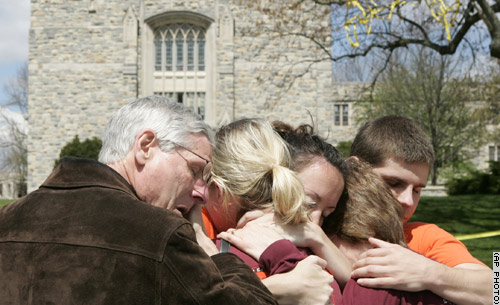 The Virginia Tech community has already held several official mourning and memorial events; Linenthal says memorializing is a way of containing and eventually moving beyond a tragedy. But he finds a tempting deception in the rush to memorialize: “It may provide us with a much-too-illusory comfort that it is, in fact, over.†Those are chilling words, especially for those who memorialized the Columbine tragedy with the hope that such massive school violence would never happen again. “If we can put it away and say it’s over, it’s very consoling. But we don’t know whether it’s over or not. In a sense, we’re memorializing in the midst.â€
The Virginia Tech community has already held several official mourning and memorial events; Linenthal says memorializing is a way of containing and eventually moving beyond a tragedy. But he finds a tempting deception in the rush to memorialize: “It may provide us with a much-too-illusory comfort that it is, in fact, over.†Those are chilling words, especially for those who memorialized the Columbine tragedy with the hope that such massive school violence would never happen again. “If we can put it away and say it’s over, it’s very consoling. But we don’t know whether it’s over or not. In a sense, we’re memorializing in the midst.â€
Apr
19
TV Review: PBS’s “The Muslim Americans” Disappoints
April 19, 2007 | 1 Comment
Photo: Muslim American teens Farah and Sarah Albani, interviewed by Judy Woodruff for the PBS documentary, “The Muslim Americans.” (Photo from the PBS website)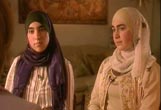
As part of its 11-part documentary series on the post-9/11 world, “America at a Crossroads,†PBS last night broadcast “The Muslim Americans,†a one-hour segment that was panned by the New York Times’ Virginia Heffernan, who called it a “public service announcement,†and by Greg Kamiya, who described the show in a Salon.com article as “standard feel-good multiculturalism, perfectly decent but not offering much original insight.†ReligionWriter agrees with those characterizations and notes the following:
Weaknesses: The correspondents showed a less-than-sophisticated grasp of Islam in general and the dynamics of the American Muslim community in particular. MacNeil/Lehrer correspondent Spencer Michels referred throughout his reporting to the religion of “ISS-lim,†rather than using the standard and correct pronunciation, “Is-LAAM.†This lack of awareness and/or depth-of-reporting was also reflected in Michel’s seeming surprise and incredulity when an immigrant Muslim said he was worried about Muslim youth drifting towards extremism. Correspondent Judy Woodruff presented two teenage Muslim sisters with little depth, leaving unchallenged a statement from one that she would not date, but rather follow her religion and marry when the time was right.
In general, the correspondents presented at face value most of the statements made by the Muslims featured in the show rather than exploring, investigating or sourcing them. Robert MacNeil, in his narration of the show, said several times that young American Muslims have increasingly embraced their religious identity since 9/11, yet the show offered little evidence to back up this claim.
Bright Spots: The show brought the life and work of Rami Nashashibi and his
For more and better analysis of the American Muslim experience, see:
“American Islam: The Struggle for the Soul of a Religion,†by Paul Barrett (Farrar, Straus and Giroux: 2007)
“Muslim Women in America: The Challenge of Islamic Identity Today,†by Yvonne Haddad, Jane Smith and Kathleen Moore (
“Islam and the Blackamerican: Looking Toward the Third Resurrection,†by
“Living Islam Out Loud: American Muslim Women Speak,†by Saleemah Abdul-Ghafur (Beacon Press: 2005) Altmuslim.com for Muslim American news, analysis and opinion.